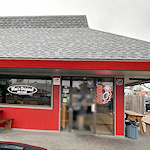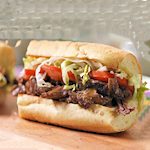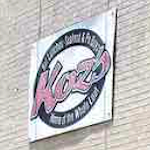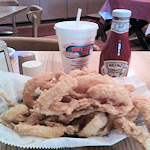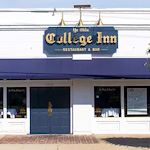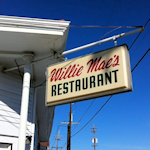A Lakeview neighborhood institution for decades, Charlie's Deli, as it was more commonly called, served up real, New York deli-style fare made right in front of you. Or at least what you could see through the deli cases that separated the dining area from the galley kitchen. An outlier in a town full of po-boy shops, Charlie's was the destination for fans of real pastrami and corned beef piled high on good Jewish rye.
If you were lucky, you could get one of the few, coveted parking spots right in front, otherwise you parked on the street. As you entered, on the left, at the front end of a line of glass-fronted cooler cases holding the meats, cheeses, salads, etc, was a short few feet of counter space where you placed your order, paid, and picked up your food when ready.
Behind the counter, high on the wall, was a chalkboard style menu listing, in addition to regular offerings like pastrami, turkey and Reuben sandwiches, specialties such as the "Wolfie" or the "Moon". Both were overstuffed combinations of meats and cheese, the latter named for former New Orleans mayor Moon Landrieu.
Dining in typically meant having to stand near the front waiting for a table to open up during busy times, and hoping your order wouldn't be ready before one did. Once a table was secured, it usually needed a wipe-down of whatever stickiness the previous occupant left behind. Handwritten signage warned diners to clean their own tables lest they incur the "wrath of Sharon", but those who didn't were apparently out the door before it could be invoked, leaving the clean-up to those who came after.
The typical sandwich construction went something along these lines: A generous portion of meat (or meats) for a sandwich, thinly sliced, of course, was piled high on a paper plate and topped with sliced Swiss cheese. This amalgamation would then be placed in a drawer-style steamer to gently heat the meat and melt the cheese. A few pumps of the handle on the front and, voila! This would all then be transferred to authentic deli rye bread slices for further amendment with Russian dressing, slaw, sauerkraut or the like.
Charlie's rounded out its "New York-ness" with shelving and racks along the wall opposite the counter filled with Kosher grocery items like matzos and gefilte fish, mostly Manischewitz brand, and none of which I ever saw anyone purchase during any of the probably one hundred times I ate there.
The "Charlie" of Charlie's Deli was Charlie Young, noted for being the originator of New York style delicatessens in New Orleans. The Lakeview outlet was the second of two Young owned before selling the Harrison Avenue location and opening another in Metairie.
Charlie had also been a trumpet player in several area dance orchestras, and was for many years the bugler at the Fairgrounds race course.
In the summer of 1986, then 62 year-old Young was working the night shift at a Metairie Time Saver convenience store. A teen-aged armed robber, under the influence of LSD, alcohol and other drugs, shot and killed him, taking a paltry $11, the money used to buy fishing bait. The jury deliberated for just 35 minutes before convicting him of first-degree murder.
After Charlie's Deli became a casualty of Hurricane Katrina, it was succeeded in the spot by Touche Café, Dan’s Place, then an iteration of Koz's, and currently by Francesca by Katie's. The latter pays homage to Charlie's in the form of the Moon sandwich.
Charlie's Deli: Sandwiches/Deli, 515 Harrison Ave, New Orleans (Lakeview) - 486-1766 (do not call) map
Francesca's by Katie's: Sandwiches/Deli/Pizza, 515 Harrison Ave, New Orleans (Lakeview) - (504)266-2511 map


